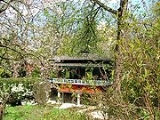
Cluj-Napoca Botanical Garden
Encyclopedia
The Cluj-Napoca Botanical Garden, officially Alexandru Borza Cluj-Napoca University
Botanic Garden , is a botanical garden
in Cluj-Napoca
, Romania
. It was founded in 1920 by Alexandru Borza
.
 The garden is over 14 hectares in area, with over 10,000 plant
The garden is over 14 hectares in area, with over 10,000 plant
s from throughout the world
. It is divided into ornamental
, phytogeographic
(geobotanical), systematic (taxonomical
), economic, and medicinal sections. Romanian flora
and vegetation
are represented by plants from the Transylvania
n plains, the Carpathian Mountains
, Banat
, etc.
Among the Botanical Garden's interesting attractions are the Japanese Garden (a garden in Japanese style, with a brook and a Japanese-style house), the Roman Garden with archeological remains from the Roman
colony of Napoca, among them a statue of Ceres, goddess of cereal
s and bread
, alongside cultivated plants that dominate contemporary Romanian agriculture
.
Babes-Bolyai University
The Babeș-Bolyai University in Cluj-Napoca is an university in Romania. With almost 50,000 students, the university offers 105 specialisations, of which there are 105 in Romanian, 67 in Hungarian, 17 in German, and 5 in English...
Botanic Garden , is a botanical garden
Botanical garden
A botanical garden The terms botanic and botanical, and garden or gardens are used more-or-less interchangeably, although the word botanic is generally reserved for the earlier, more traditional gardens. is a well-tended area displaying a wide range of plants labelled with their botanical names...
in Cluj-Napoca
Cluj-Napoca
Cluj-Napoca , commonly known as Cluj, is the fourth most populous city in Romania and the seat of Cluj County in the northwestern part of the country. Geographically, it is roughly equidistant from Bucharest , Budapest and Belgrade...
, Romania
Romania
Romania is a country located at the crossroads of Central and Southeastern Europe, on the Lower Danube, within and outside the Carpathian arch, bordering on the Black Sea...
. It was founded in 1920 by Alexandru Borza
Alexandru Borza
Alexandru Borza was a Romanian botanist, Greek-Catholic monk and honorary protopop of Cluj.As part of a group of professors, physicians, soldiers, etc., he helped bring Scouting to Romania....
.

Plant
Plants are living organisms belonging to the kingdom Plantae. Precise definitions of the kingdom vary, but as the term is used here, plants include familiar organisms such as trees, flowers, herbs, bushes, grasses, vines, ferns, mosses, and green algae. The group is also called green plants or...
s from throughout the world
Earth
Earth is the third planet from the Sun, and the densest and fifth-largest of the eight planets in the Solar System. It is also the largest of the Solar System's four terrestrial planets...
. It is divided into ornamental
Ornamental plant
Ornamental plants are plants that are grown for decorative purposes in gardens and landscape design projects, as house plants, for cut flowers and specimen display...
, phytogeographic
Phytogeography
Phytogeography , also called geobotany, is the branch of biogeography that is concerned with the geographic distribution of plant species...
(geobotanical), systematic (taxonomical
Taxonomy
Taxonomy is the science of identifying and naming species, and arranging them into a classification. The field of taxonomy, sometimes referred to as "biological taxonomy", revolves around the description and use of taxonomic units, known as taxa...
), economic, and medicinal sections. Romanian flora
Flower
A flower, sometimes known as a bloom or blossom, is the reproductive structure found in flowering plants . The biological function of a flower is to effect reproduction, usually by providing a mechanism for the union of sperm with eggs...
and vegetation
Vegetation
Vegetation is a general term for the plant life of a region; it refers to the ground cover provided by plants. It is a general term, without specific reference to particular taxa, life forms, structure, spatial extent, or any other specific botanical or geographic characteristics. It is broader...
are represented by plants from the Transylvania
Transylvania
Transylvania is a historical region in the central part of Romania. Bounded on the east and south by the Carpathian mountain range, historical Transylvania extended in the west to the Apuseni Mountains; however, the term sometimes encompasses not only Transylvania proper, but also the historical...
n plains, the Carpathian Mountains
Carpathian Mountains
The Carpathian Mountains or Carpathians are a range of mountains forming an arc roughly long across Central and Eastern Europe, making them the second-longest mountain range in Europe...
, Banat
Banat
The Banat is a geographical and historical region in Central Europe currently divided between three countries: the eastern part lies in western Romania , the western part in northeastern Serbia , and a small...
, etc.
Among the Botanical Garden's interesting attractions are the Japanese Garden (a garden in Japanese style, with a brook and a Japanese-style house), the Roman Garden with archeological remains from the Roman
Roman Empire
The Roman Empire was the post-Republican period of the ancient Roman civilization, characterised by an autocratic form of government and large territorial holdings in Europe and around the Mediterranean....
colony of Napoca, among them a statue of Ceres, goddess of cereal
Cereal
Cereals are grasses cultivated for the edible components of their grain , composed of the endosperm, germ, and bran...
s and bread
Bread
Bread is a staple food prepared by cooking a dough of flour and water and often additional ingredients. Doughs are usually baked, but in some cuisines breads are steamed , fried , or baked on an unoiled frying pan . It may be leavened or unleavened...
, alongside cultivated plants that dominate contemporary Romanian agriculture
Agriculture
Agriculture is the cultivation of animals, plants, fungi and other life forms for food, fiber, and other products used to sustain life. Agriculture was the key implement in the rise of sedentary human civilization, whereby farming of domesticated species created food surpluses that nurtured the...
.

